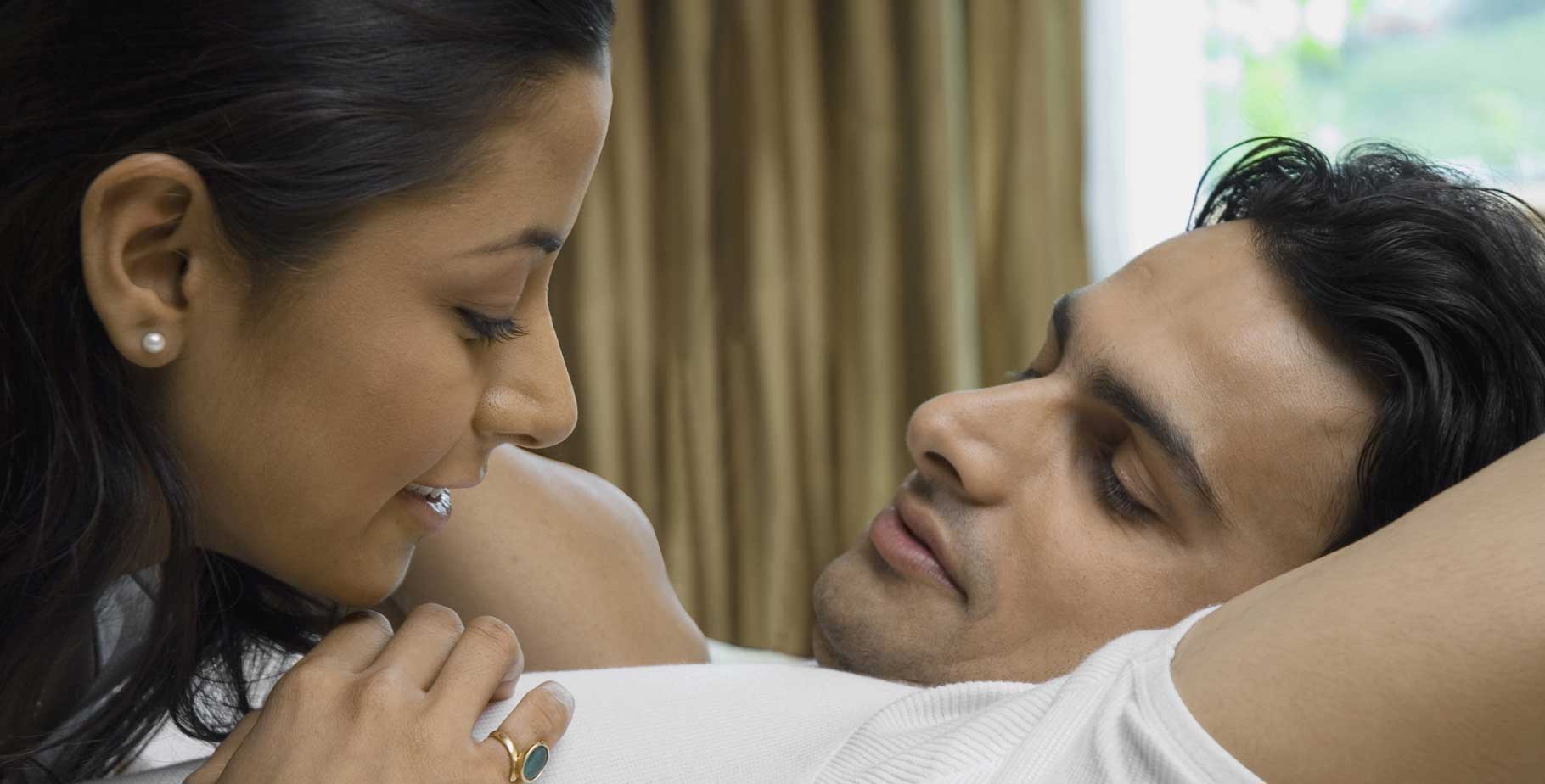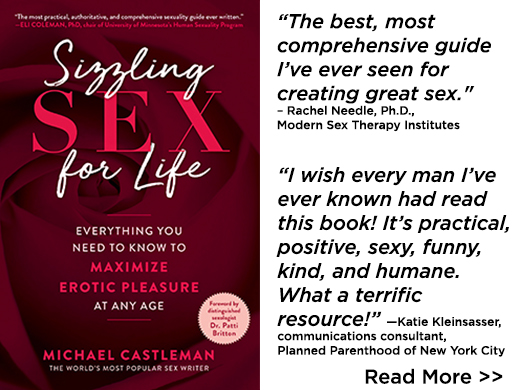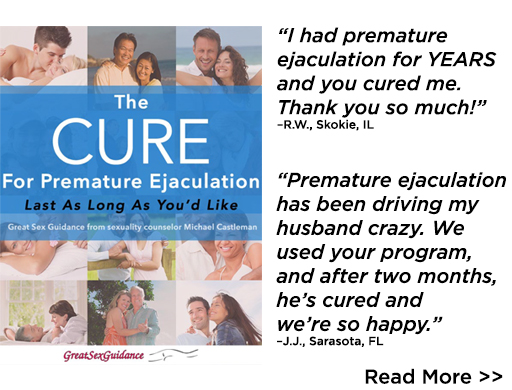
Many women suffer sexual pain. It can occur at any age, but beyond pain associated with early sexual experiences, sex-related genital pain often occurs after age 40.
The landmark 1999 survey, Sex in America, estimated that 20 percent of American women experience pain on intercourse. Other surveys suggest that 15 percent of premenopausal women and 33 percent of postmenopausal women complain of genital pain. Genital pain and pain on intercourse are frequent reasons why women consult gynecologists and sex therapists.
Women experience two kinds of sexual pain: chronic genital pain independent of lovemaking, and pain during sex, typically during intercourse.
Unfortunately, until recently, doctors often dismissed women’s genital or sexual pain (medically: dyspareunia or vulvodynia) as “neurotic” and suggested they consult a psychiatrist. This left women doubly wounded—in pain, and made to feel emotionally troubled as well.
Compounding the problem, some men haven’t believed women who said they experienced sexual pain. Others have believed, incorrectly, that sex is supposed to be painful for women. But that situation is changing. “Guys I see in therapy often feel really guilty about lovers’ pain during intercourse,” says sex therapist Dennis Sugrue, Ph.D., a former president of the American Association of Sex Educators, Counselors, and Therapists. “They don’t understand it. They’re convinced it’s their fault. They want sex, but they don’t want to hurt their lovers.”
Pain is a mind-body experience. It has both physical and emotional components. For example, stress, anxiety, and depression make all pain hurt more no matter where in the body it occurs. Having pain exacerbated by psychological factors does not mean you’re neurotic. It simply means you have some psychological factors aggravating the physical causes of your pain. It helps to identify both pain’s physical and psychological components because each responds to different treatments. Even if one component resists treatment, you may experience significant relief by treating the other.
Genital Play and Intercourse Should Never Hurt
Attention, men: Forget those song lyrics about how love “hurts so good.” Genital play and intercourse should never hurt. Some men feel so eager to plunge into intercourse that they ignore or dismiss women’s complaints about discomfort and pain. Big mistake. If sex hurts her, she can’t become aroused or responsive, which means unsatisfying sex for both of you. Not to mention that she’s likely to resent you (or worse). Your relationship may suffer serious strains. And she might complain to her friends that you’re a lousy lover.
Most Sexual Pain Can Be Cured
The good news is that sexual pain can usually be resolved. In a two-year study, two-thirds of women with sexual pain reported significant improvement.
There are many possible causes of sexual pain in women over 40:
Lack of Lubrication
In pornography, women become wet between the legs when an attractive man walks into the room. That’s total garbage. Many perfectly normal women don’t produce much vaginal lubrication, even when they feel highly aroused by partners they love deeply. Lubrication problems become particularly common after age 40, as women begin to experience menopausal changes. Intercourse without sufficient lubrication is a major cause of women’s sexual pain.
Nonsensual Lovemaking
Attention, men: It takes women considerably longer than men to feel sufficiently aroused and relaxed to enjoy intercourse comfortably. If men push into women before they feel truly receptive, they experience pain. The key to pain-free lovemaking is sex based on leisurely, playful, whole-body sensuality. Men should consciously slow the pace of lovemaking. Intercourse can wait. Give women all the time they need to become relaxed, aroused, and receptive. A man should tell his lover: I won’t attempt to enter you until you invite me in. Then be creative. Kiss, hug, roll around, massage each other, and enjoy oral sex and other caresses, play with sex toys—anything you both enjoy. “Warm-up time is very important,” says San Francisco sex therapist Linda Alperstein. “Men need to allow women the time they need. And women need to insist on making love at a pace that gives them the time they need to become aroused.” Most sex therapists recommend at least 30 minutes of kissing, cuddling, and mutual whole-body massage, and oral sex before attempting intercourse.
Cunnilingus can supplement women’s natural vaginal lubrication. Or use a commercial lubricant, or vegetable oil (though it might stain linens). Once women become menopausal, most need extra lubrication every time. “Use lubricant on her vulva and vagina and your penis,” advises Palo Alto, California, sex therapist Marty Klein, “and after a while, use some more. I recommend lube to everyone every time.”
The Man Pushing In Too Quickly Or Deeply
Even if women are highly aroused and well lubricated, they may experience pain if men push into them too forcefully, the way the male actors often do in pornography. Men should not try to imitate porn. They should ease in slowly.
The skin around the vaginal opening is richly endowed with touch-sensitive nerve endings. Rubbing the head of the penis on her vaginal lips before entering her is erotically stimulating, and helps women warm up to intercourse. When the penis enters the vagina, men should slide in slowly. The vagina is not a hollow space like the inside of a basketball. It is comprised of folds of muscular tissue that yield most comfortably when the penis enters slowly.
Men should be especially careful about depth of insertion in the doggie position, which allows unusually deep penetration—and may cause pelvic pain or abdominal pain during and/or after intercourse. To enjoy this position, the man should initially remain still. The woman should move back onto the penis. She should be in control of the speed and depth of insertion. This way, she can identify her comfort zone, and let the man know how deeply he can insert without causing her pain. Similar issues arise in the woman-on-top position. Again, the man should lie still at first. The woman should slowly sit down in his erection, controlling the speed and depth of insertion.
Relationship Issues
If a woman’s relationship causes her emotional pain, she may experience physical pain during sex. If you’ve been fighting more than usual, or if a relationship crisis has occurred recently, for example, an affair, the woman might experience pain on intercourse. While it’s a mistake to jump to the conclusion that sexual pain means a serious relationship problem—there are many physical causes of sexual pain—nonetheless, relationship issues may cause or contribute to sexual pain. If you suspect a relationship issue, consult a couples counselor or sex therapist to help deal with your issues.
Birth Control Pills
Vuvlar pain expert Andrew Goldstein, M.D., editor of the medical text, Female Sexual Pain Disorders, says that today’s birth control pills are “one of the leading causes of women’s sexual pain.” Compared with pills prescribed before the 1980s, the pills prescribed since then have a different formulation, one that causes overproduction of a protein called sex hormone-binding globulin (SHBG). This protein binds to male sex hormones (androgens) in vulvar tissue, and causes a cascade of biochemical changes that produces pain. Goldstein says that women with pelvic/sexual pain should stop taking birth control pills and take supplemental estrogen and androgens to normalize the levels of these hormones in vulvar tissue. With this treatment, he says most women with pain caused by the Pill are pain-free in six months.
Vulvar Skin Conditions
Women’s external genital skin is very sensitive to irritation. Intercourse may feel painful if this tender skin becomes chafed by: douching, pubic shaving, sunburn, an allergy to latex from condoms, or contact dermatitis from harsh or perfumed soaps, feminine hygiene products, or underwear made from synthetic, heat- and moisture-trapping fabrics. If a woman’s vulva appears red or irritated, she should consult a physician.
Sexually Transmitted Infections
Chlamydia, genital warts, and pelvic inflammatory disease may cause pain on intercourse. If pain persists despite increased sensuality and lubrication, the woman should see a doctor and ask to be screened for these infections.
Other Vaginal Infections
Chronic yeast infection, or vaginal bacterial infections (vaginosis) may cause pain on intercourse. The pain may feel worse the day after lovemaking. Yeast infections are treated with antifungal medication, bacterial infections with antibiotics.
Constipation
Constipation makes the pelvic area less flexible, which can contribute to pain. It also makes women feel bloated, uncomfortable, and self-conscious, which can aggravate any sexual discomfort. Constipation is very common. U.S. laxative sales approach $500 million a year. Women can prevent constipation by eating a bran cereal for breakfast with fruit (especially prunes and raisins), plus a diet based on lots of fruit and vegetables, beans and whole grains; by drinking plenty of nonalcohbolic fluids; getting regular moderate exercise, e.g. brisk walking for at least 30 minutes a day; and never ignoring the urge to go.
Emotional Trauma and Childhood Sexual Abuse
Years after sexual abuse, some survivors experience genital pain or pain during intercourse. In a recent Canadian study, compared with women who had vulvar medical problems but no pain, those who had genital pain reported more life stresses: job and relationship problems, recent marriage or childbirth, the death of someone close, and/or a history of sexual abuse. There may be a time lag of months or even years between the traumatic event and the onset of the pain. Sex therapy can help you overcome the lingering effects of the trauma. Survivors of child sexual abuse may also benefit from the excellent book, The Survivor’s Guide to Sex: How to Have an Empowered Sex Life After Child Sexual Abuse by Staci Haines (Cleis Press, San Francisco, 1999).
Oxalate Irritation
Oxalates are byproducts of the oxalic acid in some foods. Women sensitive to oxalates may develop urethral irritation, which can cause pain on intercourse. High-oxalates foods include: celery, coffee, chocolate, rhubarb, spinach, and strawberries. A more extensive list can be obtained from the Vulvar Pain Foundation (vulvarpainfoundation.org). It can take three to six months on a low-oxalate diet to experience improvement. Another way to reduce oxalate irritation is to take a calcium citrate supplement, for example, Citracal. Women interested in this approach should discuss dosage with their doctors.
Vaginismus
Vaginismus causes spasms of the pelvic floor muscles, which makes them clamp down and close the vaginal opening. In mild cases, intercourse is possible, but causes discomfort. In severe cases, insertion is impossible and attempts may cause sharp pain. During any medical evaluation for pain on intercourse, the doctor should check for vaginismus. If it’s diagnosed, the condition is best treated by a physician-sex therapist team. Standard therapy includes Kegel exercises, biofeedback-based pelvic muscle relaxation exercises, and gentle insertion of graduated dilator rods that gradually coax the vagina open enough to receive an erection.
Vulvar Vestibulitis (VV)
This poorly understood condition involves inflammation of the vestibular glands, tiny glands inside the vaginal opening, notably the Bartholin’s glands, which produce some vaginal lubricating fluid. To test for VV, the clinician presses a Q-tip into the tissue around the opening. In women with VV, Q-tip pressure causes sharp pain. Some VV clears up with time and supplemental lubrication. Other potentially helpful treatments include: Kegel exercises, a low-oxalate diet, and participation in a support group.
Biofeedback may also be beneficial. Many women with VV have trouble relaxing their pelvic floor muscles. Unlike vaginismus, these muscles don’t clamp down, closing the vaginal opening. Instead, they become tense, which makes intercourse painful. Biofeedback can teach women to relax their pelvic floor muscles. Cornell researchers taught 33 VV sufferers pelvic floor relaxation using home biofeedback equipment fitted with small, tension-sensing electrodes placed in their vaginas. After 16 weeks, the women’s pelvic floor muscles were more relaxed and stronger. The women reported significantly less VV pain. Researchers in Montreal, Canada, worked with 35 VV sufferers. Using a relaxing combination of deep breathing, self-massage, biofeedback, and simulated intercourse with dildos, within a year, 72 percent reported noticeable improvement. Women with VV should consider asking their physicians for a referral to a biofeedback therapist, or contact the Association for Applied Psychophysiology and Biofeedback for a list of certified biofeedback therapists near them.
Finally, VV can be treated with surgical removal of the vestibular glands (vestibulectomy). Researchers at McGill University in Canada tried three treatments on 78 VV sufferers: education and Kegel exercises, biofeedback, and surgery. Six months later, 35 percent of the biofeedback group reported significant improvement, 39 percent of the education/exercise group, and 68 percent of those who had vestibulectomies. It’s prudent to try the noninvasive approaches before opting for surgery.
Other Medical Conditions
Many other conditions can contribute to women’s pain on intercourse, among them: uterine prolapse, endometriosis, interstitial cystitis, irritable bowel syndrome, and gynecological cancers. A VV work-up should investigate all of them.
For more information about pain on intercourse, contact: the International Pelvic Pain Society (pelvicpain.org), the National Vulvodynia Association (nva.org), or the Vulvar Pain Foundation (vulvarpainfoundation.org).
Message to men: If your lover complains of discomfort or pain on intercourse, don’t criticize her for resisting you and sabotaging lovemaking. Instead, slow things down, embrace a more sensual style of lovemaking, and used plenty of lubricant. If the problem persists, urge her to consult a physician for investigation of the conditions discussed above, and if that doesn’t resolve the problem, the two of you might consult a sex therapist. Remember, intercourse is not necessary for enjoyable, mutually fulfilling sex. While she’s being treated, you can still have great sex using your hands and tongues and perhaps sex toys—everything but your penis inside her vagina.
Sexual pain is often medically complex and emotionally trying. Women appreciate men who take their pain seriously, men who are patient and supporting during its evaluation and treatment.
Issues Women Should Discuss with Clinicians
- Where does it hurt? Being as specific as possible can help pinpoint the cause(s). Pain in the outer vagina suggest vestibulitis, or possibly scar-related pain from previous episiotomies. Pain deep in the vagina may mean the penis is banging into the cervix. Or it may have to do with vaginal shortening during hysterectomy or other pelvic surgery. Or you may have endometriosis.
- When do you feel pain—before, during, or after intercourse? If you experience pain before intercourse, you may have tissue irritation or an infection, for example, yeast, UTI, bacterial vaginosis, trichomonas, herpes, or genital warts. The infection may not have typical symptoms so your doctor may have missed it.
Pain that begins shortly before intercourse may have to do with the expectation of nonsensual, rushed lovemaking. It may also relate to past sexual trauma.
Pain during intercourse might be vaginismus or vulvar vestibulitis. It might also be caused by micro-abrasions to tender vaginal tissue. A sexual lubricant can help prevent and treat this.
Pain after intercourse might be vestibulitis , or a sign of poor muscle tone in the pelvic floor. If so, Kegel exercises might help.
- How does the pain feel? Is it aching? Throbbing? Stabbing? Burning? What? Describing the quality of pain can help with diagnosis.
- Can you masturbate to orgasm without pain? If yes, then the search for physical causes should focus inside the vagina. It’s also possible that situational relationship factors may play a part in the problem.
- Does using a sexual lubricant relieve your pain? If so, use lots of lube every time.
- If you’ve had more than one sex partner recently, does the pain happen with just one of them, or all? If just one, relationship and lovemaking issues may be involved: a lack of whole-body sensuality and/or the man rushing into intercourse before you’re fully aroused and lubricated. Sexual position may also be involved in pain. In particular, some women find doggie-style rear entry intercourse uncomfortable because it allows unusually deep thrusting. Relationship issues may also play a role: conflicts, disappointments, and other stresses. Consult a sex therapist to help deal with them.
If you suffer genital pain or pain on intercourse, take this article—and the citations below—to your physician and/or sex therapist and explore the various points together. But be aware of the fact that not every internist or gynecologist is an expert in sexual medicine. To find such an expert, contact a sex therapist. To find a sex therapist near you, visit the American Association of Sex Educators, Counselors, and Therapists, the Society for Sex Therapy and Research, or the American Board of Sexology.
References:
Bergeron, S et al. “A Randomized Comparison of Group Cognitive-Behavioral Therapy, Biofeedback, and Vestibulectomy in the Treatment of Dyspareunia Resulting from Vulvar Vestibulitis,” Pain (2001) 91:297.
Binik, Y.M. et al. “Female Sexual Pain Disorders: Genital Pain or Sexual Dysfunction?” Archives of Sexual Behavior (2002) 31:425.
Dunn, K.M. et al. “Systematic Review of Sexual Problems: Epidemiology and Methodology,” Journal of Sex and Marital Therapy (2002) 28:399.
Graziottin, A. “Clinical Approach to Dyspareunia,” Journal of Sex and Marital Therapy (2001) 27:489-501.
Graziottin, A. et al. “Vulvodynia: The Challenge of Unexplained Genital Pain,” Journal of Sex and Marital Therapy (2001) 27:503-512.
Graziottin, A and L.A. Brotto. “Vulvar Vestibulitis: A Clinical Approach,” Journal of Sex and Marital Therapy (2004) 30:125.
Heiman, J.R. “Sexual Dysfunction: Overview of Prevalence, Etiological Factors, and Treatments,” Journal of Sex Research (2002) 39:73.
Lamont, John, et al. “Psychosexual and Social Profiles of Women with Vulvodynia,” Journal of Sex and Marital Therapy (2001) 27:551-555.
MacReady, N. “Biofeedback, Kegels Can Ease Pain in Vestibulitis,” Family Practice News 9-1-2003.
Metts, JF. “Vulvodynia and Vuylvar Vestibulitis: Challenges in Diagnosis and Management,” American Family Physician 3-15-1999. 59:1547.
Reissing, E.D. et al. “Vaginal Spasm, Pain, and Behavior: An Empirical Investigation of the Diagnosis of Vaginismus,” Archives of Sexual Behavior (2004) 33:5.
Simons, J.S. and M.P,. Carey. “Prevalence of Sexual Dysfunctions: Results from a Decade of Research,” Archives of Sexual Behavior (2001) 30:177.





